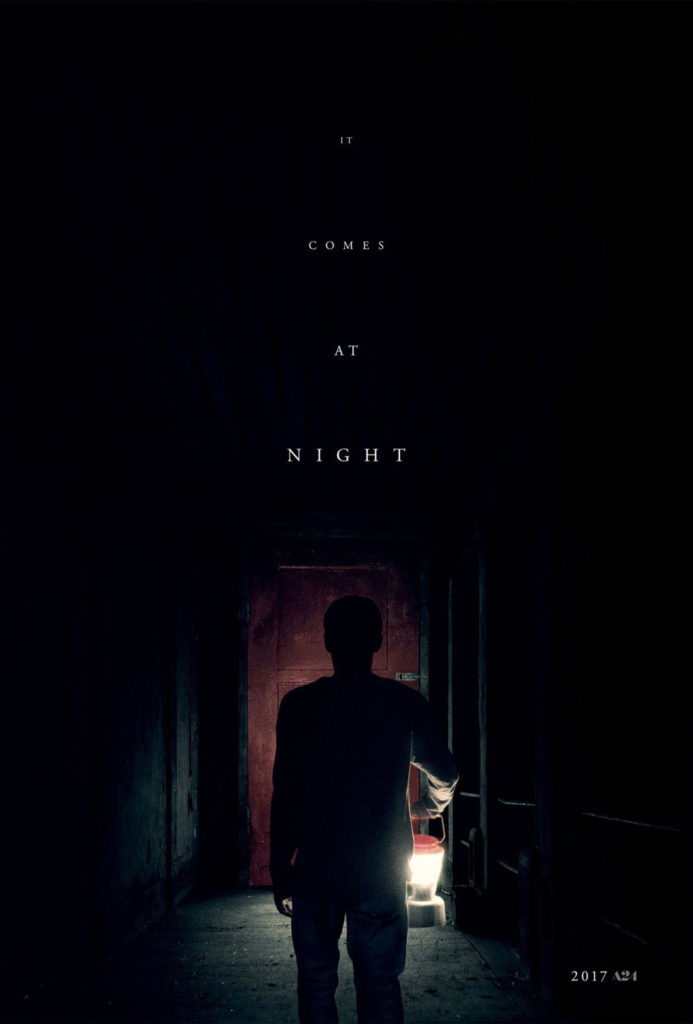Writer/director Trey Edward Shults’ psychological horror flick from this past year, It Comes at Night, is well-written, gorgeously shot, well-acted, and deeply disturbing, but it has a bad title. At first glance, It Comes at Night is a great title for a horror flick. It implies that there is an It that will be coming to terrorize cast members, most probably at night. If this were a monster or a slasher flick, or maybe even something more mysterious, this would be a great title for a film. But in a film that has no It, and which places little meaningful significance on the night, it’s a terrible title. Perhaps Shults had this great title and this great screenplay, and decided to put them together, with little regard to whether or not they were beneficial to each other. Either way, the result is the audience being sold a false bill of goods, which is a shitty thing to do to viewers even if the end result is a good film.
It Comes at Night takes place deep in the woods somewhere (it was filmed in upstate New York). Some sort of infection has caused the collapse of civilization, and a small family, consisting of Paul (Joel Edgerton), Sarah (Carmen Ejogo), and teenaged Travis (Kelvin Harrison Jr.) is surviving on their own in a secluded house.
Their peace is disturbed by the sudden arrival of Will (Christopher Abbott). The first meeting doesn’t go so well, but eventually Will convinces Paul and the others to allow his wife and  young son, Kim and Andrew (Riley Keough and Griffin Robert Faulkner) to come and stay at the house. Safety in numbers, and all that.
young son, Kim and Andrew (Riley Keough and Griffin Robert Faulkner) to come and stay at the house. Safety in numbers, and all that.
There’s an underlying tension between the two merged groups that pervades the situation, but they try their best to overcome any suspicions or mistrust. They all want nothing more than to survive and to protect their respective families. But that means having to rely on each other in ways they might not be prepared to do.
Paul is the overriding presence in this film. He’s the alpha male and also the person expected to make all the hard decisions. At times that means treating people harshly. The thing is, even when his behavior is at its most abhorrent, and it gets to that place on multiple occasions, it is justifiable. He might not be making the decisions with the best outcomes, but it’s hard to fault his reasoning. It’s never made clear how long ago the mystery infection spread, or what has happened to make Paul so ruthless, but the character most affected by Paul’s actions, Will, is never shocked by what goes on. It’s well within the bounds of what he sees as acceptable. Something really bad has happened out beyond the woods, and everyone in this film is terrified that it will make its way to their sanctuary.
And what a sanctuary it is.
The house is sealed tight. It’s a multistory affair with numerous exterior stairways and doors, but those have been boarded up, as well. The only way in and out is through a shiny red door at the end of a long hallway. The living areas are nonsensical and nonlinear, and that’s by design. Much like the Overlook Hotel in The Shining, the house in this film is never presented in a logical fashion. It’s a technique that I think has more effect on the subconscious mind than the conscious. The house becomes a source of unease in the viewer before one even realizes why. It’s used to great effect.
Over the remaining course of the film, the uneasy relationship between the two groups begins to break down, leading to denouement. The climax is swift, brutal, and horrifying. All the tension that pervades the film explodes all at once.
Shults and company have crafted a very dark film. It’s the type of horror film that goes for dread over outright frights. In that, it can leave a viewer feeling a little awful after it’s all over. But, still, this is a very good film.
